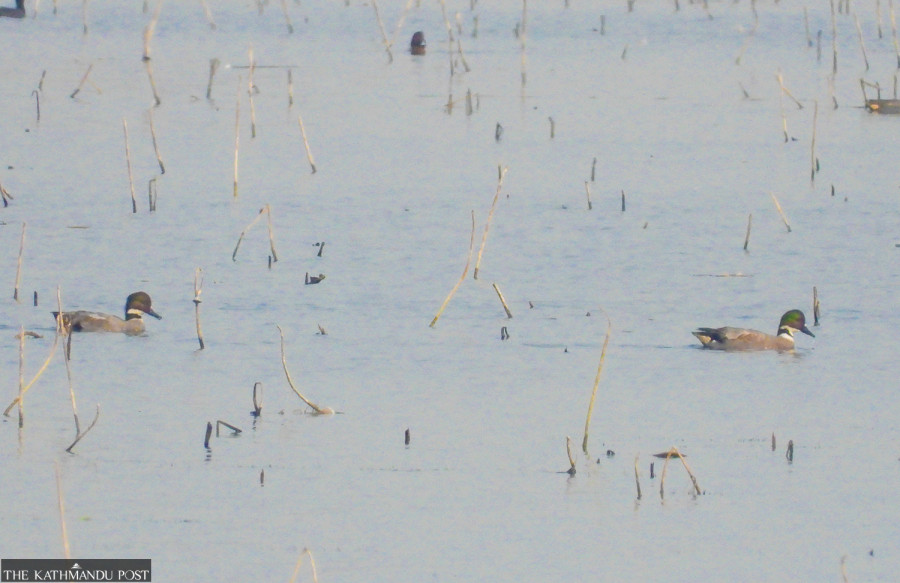Lumbini Province
In Jagadishpur, migratory birds decline for 3 consecutive years
The lake has become unsafe for birds due to increasing human activities, experts say.
Manoj Paudel
Conservationists are worried about the continuous decline of aquatic bird population in Jagadishpur lake, a bird sanctuary which is a major habitat of winter migratory birds, for three consecutive years.
The fresh bird count conducted last week showed that the population of both the migratory water birds and bird species have decreased in Jagadishpur, a Ramsar wetland site.
“The decline in the migratory bird population in Jagadishpur is quite worrisome,” said Hem Sagar Baral, a senior ornithologist. “Obviously, there are problems behind the gradual decline of the bird population. Study is underway regarding the decreasing bird population in Jagadishpur.”
According to ornithologists, around four percent of the bird population has decreased in Jagadishpur lake in 2023. A total of 9,487 birds were counted during the latest bird count. The population of migratory aquatic birds stood at 9,837 and 12,063 in 2022 and 2021, respectively.
The number of migratory birds saw an increase to 20,807 in 2020 from 14,980 recorded in the previous year.
A team of ornithologists including Baral, Tika Giri, DB Chaudhary and Dhiraj Chaudhary conducted the bird count in Jagadishpur lake on Monday. The count was held by a direct method of bird count by dividing the lake into various areas. According to the ornithologists, they use telescopes, binoculars, GPS, sound recorders and cameras to count the birds.
Jagadishpur lake, which was constructed in 1972-1973 for the purpose of irrigation, has been a major destination for bird watching in the country. It is the biggest shelter, according to the conservationists, for migratory birds.
According to Giri, a total of 49 species of aquatic birds were recorded in 2022. “Only 45 species of birds have been found in the lake this year,” he said.
Despite the fall in bird population, ornithologists are elated to spot some rare bird species in good numbers. “We spotted two Falcated ducks, locally called Phurke Hans, during the count,” DB Chaudhary said. “It is a very rare bird species in Nepal. Both the Falcated ducks were male. So we believe that there could be other female birds of the same species.”
According to him, around six or seven Falcated ducks migrate to Nepal from Siberia during winter. One Falcated duck was spotted in Barju lake of Sunsari district as well. Nearly 100 Common pochards, another globally endangered bird species, were also found in the lake.
Jagadishpur has the highest number of Common coot with 4,095, followed by Red-crested pochard at 1,930. A total of 930 Common teal, 640 Lesser whistling duck, 446 Little cormorant and 300 Great cormorant were recorded in the fresh count of water birds in Jagadishpur.
Jagadishpur lake, which was listed as a Ramsar wetland site in 2003, was declared a bird sanctuary, the country’s second, in July last year. The lake is spread over an area of 157 hectares across Kapilvastu Municipality’s wards 9 and 10, and is located some 11 kilometres north of Taulihawa, the district headquarters of Kapilvastu.
Every winter, birds migrate to the lake from Siberia, China, Mongolia, Turkmenistan and Kyrgyzstan and stay until February. Gadwall, Lesser whistling duck, Tufted duck, Ferruginous duck, Northern pintail, Northern shoveler, Eurasian wigeon, Common Pochard and Cotton pygmy-goose are the major birds found in the lake.
Jagadishpur lake is a major destination of birding in Nepal. Conservationists warn that the lake will soon lose its fame if the bird population continues decreasing every year. According to them, human encroachment is the main threat for bird conservation in the lake.
“It is not good that human activities are increasing in the lake,” Baral said. “Jagadishpur lake has become unsafe for birds due to increasing human activities and encroachments in the lake.”
Five boats are operated in the lake for the visitors. “The visitors tease and attempt to catch birds,” Baral added. “It is not good for bird conservation.”




 12.12°C Kathmandu
12.12°C Kathmandu












%20(1).jpg&w=300&height=200)

